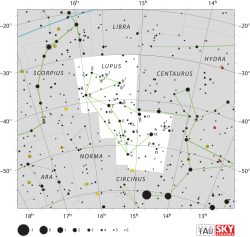Theta Lupi
| Theta Lupi (θ) | |
 | |
| Observationsdata Epok: J2000 | |
|---|---|
| Stjärnbild | Vargen |
| Rektascension | 16t 06m 35,54525s[1] |
| Deklination | -36° 48′ 08,2653″[1] |
| Skenbar magnitud () | 4,22[2] |
| Stjärntyp | |
| Spektraltyp | B2.5 Vn[3] |
| U–B | -0,734[2] |
| B–V | -0,184[2] |
| Astrometri | |
| Radialhastighet () | +6,0 ± 3,4[4] km/s |
| Egenrörelse (µ) | RA: -15,33[1] mas/år Dek.: -33,83[1] mas/år |
| Parallax () | 7,87 ± 0,47[1] |
| Avstånd | 410 ± 20 lå (127 ± 8 pc) |
| Absolut magnitud () | -1,29[5] |
| Detaljer | |
| Massa | 6,5 ± 0,1[6] M☉ |
| Radie | 4,5[7] R☉ |
| Luminositet | 792[8] L☉ |
| Temperatur | 15 395[8] K |
| Vinkelhastighet | 331[9] km/s |
| Ålder | 24,6 ± 5,2[6] miljoner år |
| Andra beteckningar | |
| θ Lup, CD-36° 10642, FK5 599, HD 144294, HIP 78918, HR 5987, SAO 207332. [10] | |
Theta Lupi (θ Lupi, förkortad Theta Lup, θ Lup), som är stjärnans Bayer-beteckning, är en ensam stjärna[11] i östra delen av stjärnbilden Vargen. Den har en magnitud av 4,22[2] och är synlig för blotta ögat där ljusföroreningar ej förekommer. Baserat på parallaxmätning inom Hipparcosuppdraget på ca 7,9 mas,[1] beräknas den befinna sig på ett avstånd av ca 410 ljusår (127 parsek) från solen.
Egenskaper
[redigera | redigera wikitext]Theta Lupi är en blå till vit stjärna i huvudserien av spektralklass B2.5 Vn,[3] där "n"-suffixet anger diffusa absorptionslinjer i dess spektrum på grund av snabb rotation med en projicerad rotationshastighet på 331 km/s,[9] vilket ger stjärnan en något tillplattad form med en ekvatorialradie som uppskattas vara 15 procent större än polarradien.[12] Den har en massa som är ca 6,5[6] gånger solens massa, en radie som är ca 4,5[7] gånger solens radie och avger ca 792[8] gånger mer energi än solen från dess fotosfär vid en effektiv temperatur på ca 15 400 K.[8]
Referenser
[redigera | redigera wikitext]- Den här artikeln är helt eller delvis baserad på material från engelskspråkiga Wikipedia, 26 januari 2019.
Noter
[redigera | redigera wikitext]- ^ [a b c d e f] van Leeuwen, F (November 2007). "Hipparcos, the New Reduction". Astronomy and Astrophysics. VizieR; Centre de Données astronomiques de Strasbourg. 474 (2): 653–664. arXiv:0708.1752. Bibcode:2007A&A...474..653V. doi:10.1051/0004-6361:20078357.
- ^ [a b c d] Gutierrez-Moreno, Adelina; Moreno, Hugo (1968), "A Photometric Investigation of the Scorpio-Centaurus Association", Astrophysical Journal Supplement, 15: 459, Bibcode:1968ApJS...15..459G, doi:10.1086/190168.
- ^ [a b] Hiltner, W. A.; et al. (July 1969), "MK Spectral Types for Bright Southern OB Stars", Astrophysical Journal, 157: 313–326, Bibcode:1969ApJ...157..313H, doi:10.1086/150069.
- ^ de Bruijne, J. H. J.; Eilers, A.-C. (October 2012), "Radial velocities for the HIPPARCOS-Gaia Hundred-Thousand-Proper-Motion project", Astronomy & Astrophysics, 546: 14, arXiv:1208.3048, Bibcode:2012A&A...546A..61D, doi:10.1051/0004-6361/201219219, A61.
- ^ Anderson, E.; Francis, Ch. (2012), "XHIP: An extended hipparcos compilation", Astronomy Letters, 38 (5): 331, arXiv:1108.4971, Bibcode:2012AstL...38..331A, doi:10.1134/S1063773712050015.
- ^ [a b c] Tetzlaff, N.; et al. (January 2011), "A catalogue of young runaway Hipparcos stars within 3 kpc from the Sun", Monthly Notices of the Royal Astronomical Society, 410 (1): 190–200, arXiv:1007.4883, Bibcode:2011MNRAS.410..190T, doi:10.1111/j.1365-2966.2010.17434.x.
- ^ [a b] Pasinetti Fracassini, L. E.; et al. (February 2001), "Catalogue of Apparent Diameters and Absolute Radii of Stars (CADARS)", Astronomy and Astrophysics (3rd ed.), 367: 521–524, arXiv:astro-ph/0012289, Bibcode:2001A&A...367..521P, doi:10.1051/0004-6361:20000451
- ^ [a b c d] McDonald, I.; et al. (2012), "Fundamental Parameters and Infrared Excesses of Hipparcos Stars", Monthly Notices of the Royal Astronomical Society, 427 (1): 343–57, arXiv:1208.2037, Bibcode:2012MNRAS.427..343M, doi:10.1111/j.1365-2966.2012.21873.x.
- ^ [a b] Uesugi, Akira; Fukuda, Ichiro (1970), "Catalogue of rotational velocities of the stars", Contributions from the Institute of Astrophysics and Kwasan Observatory, University of Kyoto, Bibcode:1970crvs.book.....U.
- ^ "tet Lup -- Star", SIMBAD Astronomical Database, Centre de Données astronomiques de Strasbourg, hämtad 2017-03-03.
- ^ Rizzuto, A. C.; et al. (December 2013), "Long-baseline interferometric multiplicity survey of the Sco-Cen OB association", Monthly Notices of the Royal Astronomical Society, 436 (2): 1694–1707, arXiv:1309.3811, Bibcode:2013MNRAS.436.1694R, doi:10.1093/mnras/stt1690.
- ^ Belle, G. T. (2012), "Interferometric observations of rapidly rotating stars", The Astronomy and Astrophysics Review, 20: 51, arXiv:1204.2572, Bibcode:2012A&ARv..20...51V, doi:10.1007/s00159-012-0051-2.





